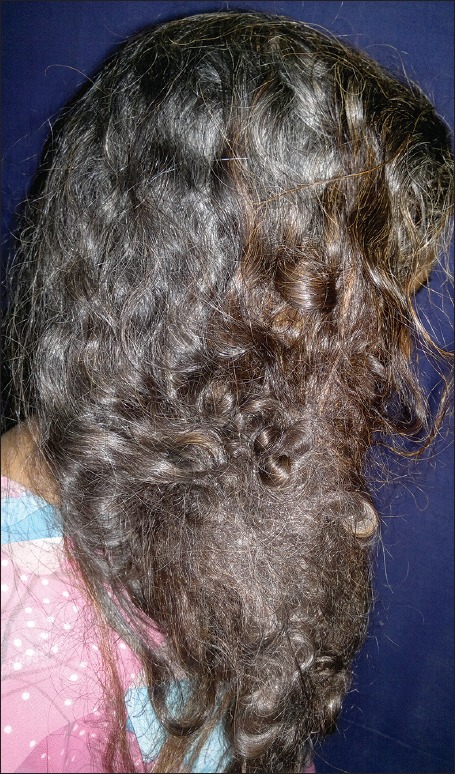A 30-year-old female presented with two days history of localized irreversibly matted scalp hair predominantly affecting vertex and occiput, mimicking a “bird's nest” [Figure 1 and 2]. The scalp was otherwise healthy and hair was normal on macroscopic as well as microscopic examination. There was no history of fever, change of soap, shampoo, or oil for hair care. Normal hair, when rubbed together did not show matting. She suffered from a similar episode six months ago for which hair on her entire scalp had to be shaved off. Examination of the scalp showed no evidence of infection or infestation. She had been taking escitalopram and clonazepam for last one year for anxiety - depression disorder. No history of similar affection in family was reported.
Figure 1.

Left lateral view showing localized irreversibly matted scalp hair, mimicking a “bird's nest”
Figure 2.

Right lateral view of scalp showing features typical of plica neuropathica
Plica neuropathica, also called plica polonica, felting or bird's nest hair, was first described by Le Page in 1884.[1] He described a 17-year-old girl with a sudden onset of tangled scalp hair and attributed this strange occurrence to “nerve force,” while the parents of the child considered it a “visitation from God.”[2] The condition, though sparsely reported in literature, is seemingly quite common among Hindu ascetics (sadhus) in India, where hair is not trimmed and proper hair care is not observed.[3]
It presents as a compact mass of scalp hair with irregular twists and irreversibly entangled plaits that form a firm to hard impenetrable mass of keratin cemented together with dirt and exudates.[2] The exact etiopathogenesis of plica neuropathica is not known. However, it has been attributed to longitudinal splitting or weathering of hair shaft due to vigorous friction and frequent use of harsh shampoos and harsh cleansers; and/or due to keeping of long hair with poor hair care or its neglect. Some other predisposing factors suggested are kinky hair and febrile illness.[4] This entity has been also found to be more frequent among psychologically disturbed women due to the repeated manipulation of the hair.[5]
The treatment of plica neuropathica involves cutting the matted hair. In the early cases, manual separation using organic solvents can be tried. Prevention includes hair care measures such as regular cleaning of the hair with mild cleansers or shampoos, gentle oiling and combing to avoid entangling, and regular hair trimming. Piling hair over the vertex while washing, and backcombing should be avoided.[4]
Footnotes
Source of Support: Nil
Conflict of Interest: None declared.
REFERENCES
- 1.Ghodake NB, Singh N, Thappa DM. Plica neuropathica (polonica): Clinical and dermoscopic features. Indian J Dermatol Venereol Leprol. 2013;79:269. doi: 10.4103/0378-6323.107674. [DOI] [PubMed] [Google Scholar]
- 2.Kumar PN, Antony B, Chakravarthy A, Koyamu AM. Plica neuropathica (polonica) in schizophrenia – A case report and review of literature. Indian J Psychiatry. 2001;43:281–3. [PMC free article] [PubMed] [Google Scholar]
- 3.Kanwar AJ, De D. Plica neuropathica in a 2-year-old boy. Int J Dermatol. 2007;46:410–1. doi: 10.1111/j.1365-4632.2006.03054.x. [DOI] [PubMed] [Google Scholar]
- 4.Marshall J, Parker C. Felted hair untangled. J Am Acad Dermatol. 1989;20:688–90. doi: 10.1016/s0190-9622(89)80152-5. [DOI] [PubMed] [Google Scholar]
- 5.Khare AK. Plica neuropathica. Indian J Dermatol Venereol Leprol. 1985;51:178–9. [PubMed] [Google Scholar]


